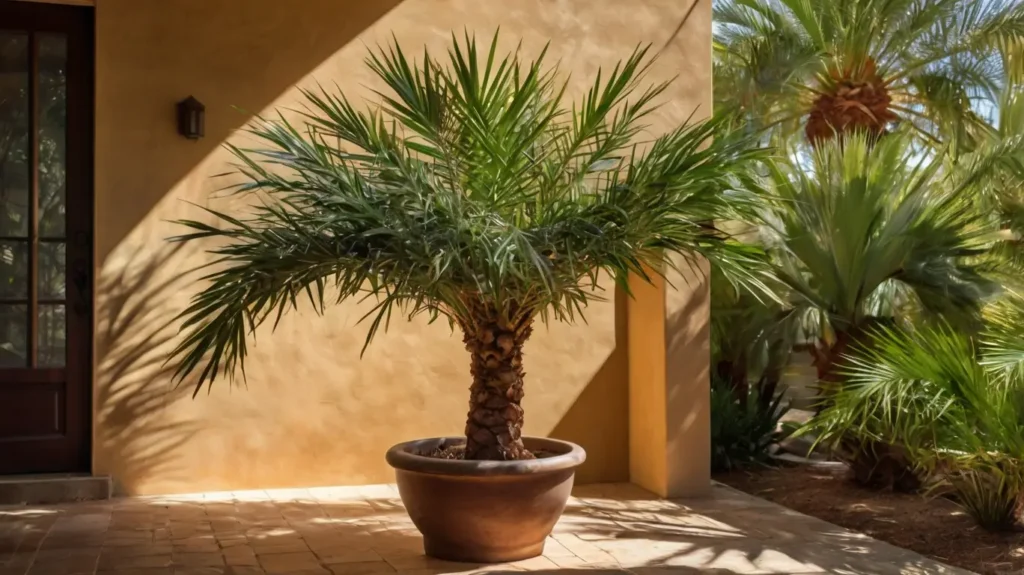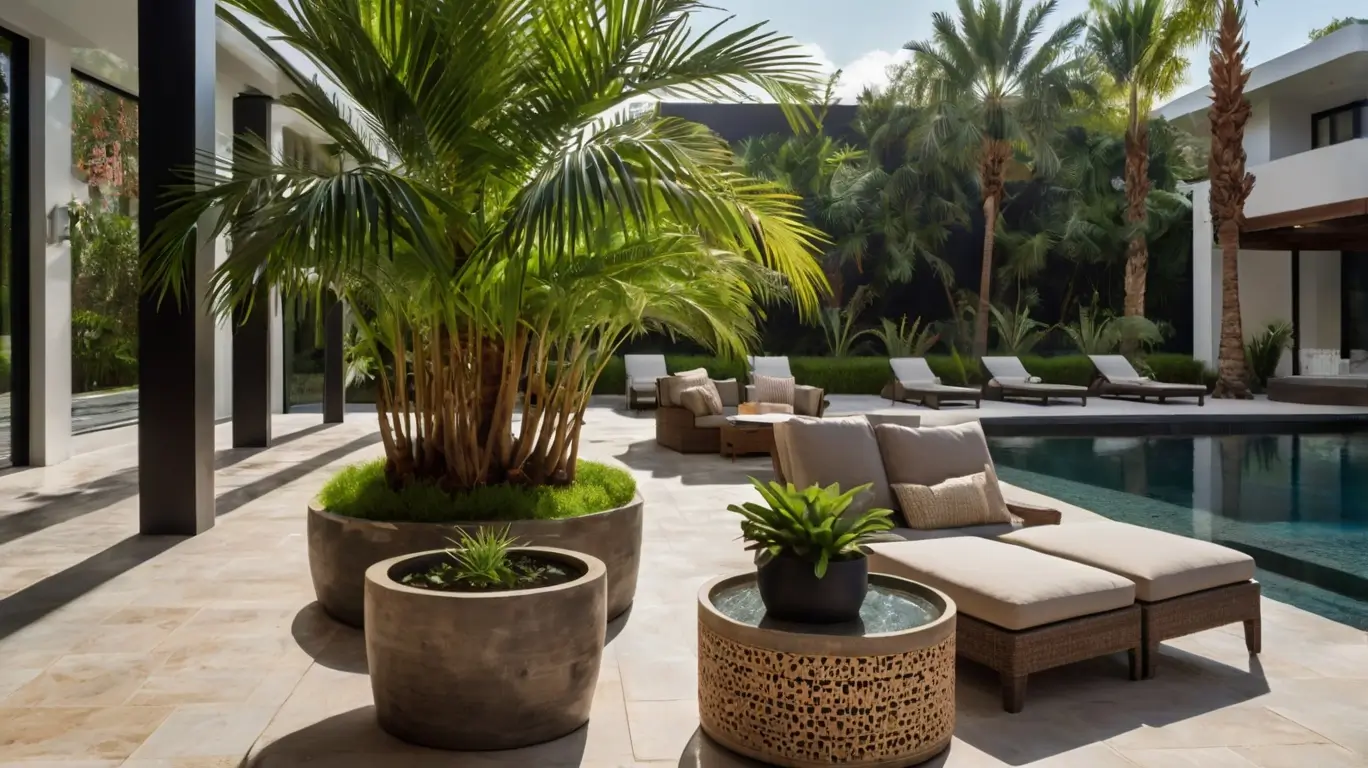Small Palm Trees for Patios: 7 Beautiful Varieties to Transform Your Outdoor Space
Introduction: Bringing a Tropical Vibe to Your Patio
Imagine the joy of stepping onto your patio and being welcomed by lush, tropical greenery. Even if your outdoor space is limited, you can create that breezy vacation feel with small palm trees for patios.
These petite yet striking trees are perfect for adding beauty and texture to a patio without requiring the room that larger palms need.
For anyone looking to spruce up their patio with greenery, small palm trees for patios bring both charm and practicality.
In this guide, you’ll discover some of the best small palm trees for patios that can add that perfect touch of elegance and make your outdoor space feel like an oasis.
1. Pygmy Date Palm (Phoenix roebelenii)
The Pygmy Date Palm is a classic choice for patios. With feathery fronds and a slow growth rate, this palm adds a tropical feel to any space without overwhelming it.
This species reaches about 4–6 feet in height, making it ideal for patios.
- Light Needs: This palm does well in partial shade, though it can handle sunlight if it’s not too intense.
- Watering Tips: It’s moderately drought-tolerant, meaning you won’t need to water it constantly. Letting the soil dry out a bit between watering sessions is best.
- Why It’s Great for Patios: The Pygmy Date Palm’s compact size and elegant look make it a favorite. Plus, its low-maintenance care makes it great for beginners.
2. Sago Palm (Cycas revoluta)
Though not a true palm, the Sago Palm fits right in with other small palm trees for patios, thanks to its unique appearance and hardy nature.
Its thick, glossy leaves and sturdy trunk bring a tropical, almost prehistoric look to any setting.
- Light Needs: Prefers partial to full sun, making it versatile for many types of patios.
- Watering Tips: This palm is quite drought-tolerant and doesn’t need much water, so you can let the soil dry out a bit between waterings.
- Height: Grows up to 2–3 feet, fitting nicely on a small patio.
This palm’s unusual appearance gives it a bold look, making it a conversation starter for any outdoor area.
3. Areca Palm (Dypsis lutescens)
The Areca Palm, or butterfly palm, is known for its arching, multi-stemmed structure that brings a dense and bushy appearance.
This makes it a wonderful natural screen or focal point for patios.
- Light Needs: Thrives in bright, indirect sunlight, making it great for partially shaded patios.
- Watering Tips: Likes to be kept in slightly moist soil, so regular watering is important. However, be careful not to let it sit in waterlogged soil.
- Height: Can grow up to 6–7 feet, though on patios it usually stays around 3–5 feet with proper trimming.
Areca Palms add a lush, privacy-friendly touch to your patio, especially if you want some extra coverage without a large hedge.
4. Parlor Palm (Chamaedorea elegans)
For shaded patios, the Parlor Palm is a perfect pick. This species is one of the few palms that thrive in low light, making it great for covered patios or those with limited sunlight.
- Light Needs: Tolerates low light, though it also does well in bright, indirect sunlight.
- Watering Tips: Moderate watering is ideal. Allow the soil to dry slightly between watering to avoid root rot.
- Height: This palm reaches about 3–4 feet, making it one of the smaller and more adaptable palms on this list.
The Parlor Palm brings a gentle, classic touch to any space, and it’s known for being a “beginner-friendly” plant.
5. Lady Palm (Rhapis excelsa)
The Lady Palm is an elegant choice for patios with its fan-shaped fronds that create a lush, full look.
It’s great for those looking for a hardy palm that can add some vertical height without taking up too much space.
- Light Needs: Prefers shaded spots, making it another good choice for covered or semi-covered patios.
- Watering Tips: Keep the soil slightly damp, but avoid overwatering. It’s best to let the top inch of soil dry out before the next watering.
- Height: Usually grows to about 4–5 feet, though it can be kept shorter with pruning.
With its graceful, fan-like leaves, the Lady Palm brings a softer, more traditional look to patios, making it a top pick for homeowners with shaded outdoor areas.
6. Dwarf Majesty Palm (Ravenea hildebrandtii)
The Dwarf Majesty Palm offers a soft, tropical look with arching fronds that create a soothing effect on patios.
This smaller variety stays at a manageable size and is perfect for adding greenery without taking over.
- Light Needs: Bright, indirect light is ideal, though it can handle some direct sunlight in the morning or late afternoon.
- Watering Tips: Keep the soil moist, but not waterlogged. When the top inch of soil feels completely dry to the touch, it’s time to water.
- Height: Stays around 5–6 feet, so it fits well on medium to large patios.
The Dwarf Majesty Palm’s delicate, feathery leaves bring a calming touch, making it an excellent addition for those who love a serene, spa-like patio vibe.
7. European Fan Palm (Chamaerops humilis)
A hardy choice that thrives in various climates, the European Fan Palm features blue-green leaves in a fan shape, adding a bold texture to patios.
- Light Needs: Can handle both full sun and partial shade, making it one of the more versatile choices.
- Watering Tips: Drought-resistant, needing minimal water once established.
- Height: Stays between 4–5 feet, making it easy to manage on patios.
The European Fan Palm’s resilience and bold look make it perfect for anyone wanting a palm that can handle tougher conditions.
How to Care for Small Palm Trees on Patios

Caring for small palm trees for patios is relatively straightforward, but attention to light, water, and soil will ensure they thrive. Here are some general tips:
- Placement Tips: Place palms based on their light needs. For example, Parlor and Lady Palms do well in shade, while the Pygmy Date and European Fan Palms can handle sun.
- Watering Tips: While each variety has its unique needs, avoid overwatering, which can lead to root rot. Typically, it’s best to let the soil dry slightly between watering sessions.
- Fertilizing: Use a balanced, slow-release fertilizer every 2–3 months during the growing season to keep your palms healthy and vibrant.
Quick Comparison Table of Small Palm Trees for Patios
| Palm Tree | Ideal Sun Exposure | Water Needs | Max Height |
|---|---|---|---|
| Pygmy Date Palm | Partial shade to sun | Moderate | 4–6 feet |
| Sago Palm | Partial to full sun | Low | 2–3 feet |
| Areca Palm | Bright indirect light | Moderate | 6–7 feet |
| Parlor Palm | Low light | Moderate | 3–4 feet |
| Lady Palm | Shade | Moderate | 4–5 feet |
| Dwarf Majesty Palm | Bright indirect light | Moderate | 5–6 feet |
| European Fan Palm | Full sun to shade | Low | 4–5 feet |
Frequently Asked Questions (FAQ)
- What are the best small palm trees for shaded patios?
Parlor Palm and Lady Palm are ideal for shaded patios due to their low light tolerance. - How much water do small palm trees need on patios?
Most small palms need moderate watering, but it depends on the species. Check the specific needs for each type. - Which small palm trees are low-maintenance?
Sago Palm and European Fan Palm are known for being low-maintenance and resilient. - Do small palm trees grow well in containers?
Yes, most small palms grow well in containers, which makes them ideal for patios.
Conclusion: Finding the Perfect Small Palm Tree for Your Patio
Adding small palm trees for patios is an easy way to create a more inviting outdoor area.
With options like the Pygmy Date Palm for sunny spots or the Parlor Palm for shaded areas, there’s a perfect choice for every patio.
By taking the time to select a palm that fits your space and climate, you’ll be rewarded with a lush, tropical retreat right at home.
Ready to choose your small palm tree for your patio and bring a touch of the tropics to your outdoor space? Start planning today and enjoy a beautiful, relaxing oasis just outside your door!

